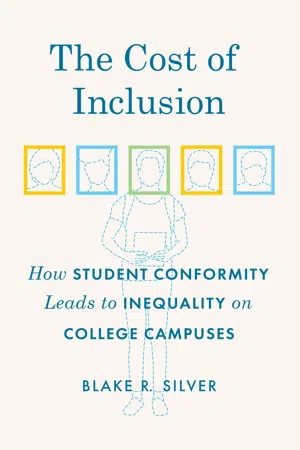
The Cost of Inclusion
How Student Conformity Leads to Inequality on College Campuses
- English
- ePUB (mobile friendly)
- Available on iOS & Android
About This Book
Young people are told that college is a place where they will "find themselves" by engaging with diversity and making friendships that will last a lifetime. This vision of an inclusive, diverse social experience is a fundamental part of the image colleges sell potential students. But what really happens when students arrive on campus and enter this new social world? The Cost of Inclusion delves into this rich moment to explore the ways students seek out a sense of belonging and the sacrifices they make to fit in.Blake R. Silver spent a year immersed in student life at a large public university. He trained with the Cardio Club, hung out with the Learning Community, and hosted service events with the Volunteer Collective. Through these day-to-day interactions, he witnessed how students sought belonging and built their social worlds on campus. Over time, Silver realized that these students only achieved inclusion at significant cost. To fit in among new peers, they clung to or were pushed into raced and gendered cultural assumptions about behavior, becoming "the cool guy, " "the nice girl, " "the funny one, " "the leader, " "the intellectual, " or "the mom of the group." Instead of developing dynamic identities, they crafted and adhered to a cookie-cutter self, one that was rigid and two-dimensional. Silver found that these students were ill-prepared for the challenges of a diverse college campus, and that they had little guidance from their university on how to navigate the trials of social engagement or the pressures to conform. While colleges are focused on increasing the diversity of their enrolled student body, Silver's findings show that they need to take a hard look at how they are failing to support inclusion once students arrive on campus.
Frequently asked questions
Information
Table of contents
- Cover
- Title Page
- Copyright Page
- Dedication
- Contents
- 1 In Search of Inclusion
- Part One: The Cookie-Cutter Self
- 2 Caregivers and the Landscape of Need
- 3 Managers, Educators, and the Dividends of Authority
- 4 Entertainers, Associates, and the Struggle for Liminal Connections
- Part Two: The Physics of Social Inclusion
- 5 Role Inertia
- 6 Centrifugal Pressure and Centripetal Elevation
- 7 Learning from the Exceptions
- Acknowledgments
- Appendix A: Study Participants
- Appendix B: A Note on Methods
- Notes
- References
- Index